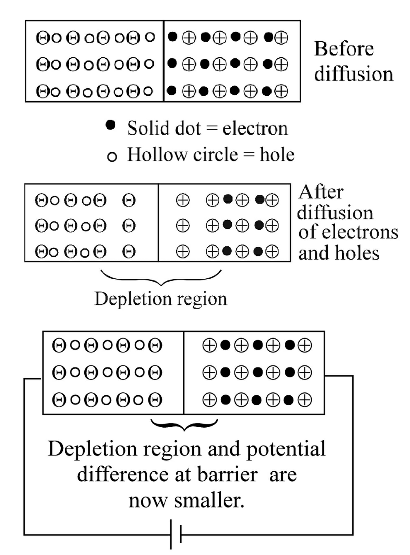Semiconductor Electronics : Materials, Devices and Simple Circuits
- In semiconductors, at room temperature
-
View Hint View Answer Discuss in Forum
In semiconductors, the conduction band is empty and the valence band is completely filled at 0 K. No electron from valence band can cross over to conduction band at 0 K. But at room temperature some electrons in the valence band jump over to the conduction band due to the small forbidden gap,
i.e. 1 eV.Correct Option: C
In semiconductors, the conduction band is empty and the valence band is completely filled at 0 K. No electron from valence band can cross over to conduction band at 0 K. But at room temperature some electrons in the valence band jump over to the conduction band due to the small forbidden gap,
i.e. 1 eV.
- Zener diode is used for
-
View Hint View Answer Discuss in Forum
At a certain reverse bias voltage, zener diode allows current to flow through it and hence maintains the voltage supplied to any load Hence, it is used for stabilisation.
Correct Option: C
At a certain reverse bias voltage, zener diode allows current to flow through it and hence maintains the voltage supplied to any load Hence, it is used for stabilisation.
- Application of a forward bias to a p–n junction
-
View Hint View Answer Discuss in Forum

Number of donors is more because electrons from –ve terminal of the cell pushes (enters) the n side and decreases the number of uncompensated pentavalent ion due to which potential barrier is reduced. The neutralised pentavalent atom are again in position to donate electrons.Correct Option: C

Number of donors is more because electrons from –ve terminal of the cell pushes (enters) the n side and decreases the number of uncompensated pentavalent ion due to which potential barrier is reduced. The neutralised pentavalent atom are again in position to donate electrons.
- Carbon, silicon and germanium atoms have four valence electrons each. Their valence and conduction bands are separated by energy band gaps represented by (Eg)C, (Eg)Si and (Eg)Ge respectively.
Which one of the following relationships is true in their case?
-
View Hint View Answer Discuss in Forum
Due to strong electronegativity of carbon.
Correct Option: A
Due to strong electronegativity of carbon.
- Choose the only false statement from the following
-
View Hint View Answer Discuss in Forum
(a) is true as in case of conductors either the conduction & valence band overlap or conduction band is partially filled.
(b) is true as insulators have energy gap of the order of 5 to 10 eV.
(c) is false as resistivity (opposite of conductivity) decreases with increase in temperature.
(d) is true as with increase in temperature more and more electrons jump to the conduction band. So, conductivity increases.Correct Option: C
(a) is true as in case of conductors either the conduction & valence band overlap or conduction band is partially filled.
(b) is true as insulators have energy gap of the order of 5 to 10 eV.
(c) is false as resistivity (opposite of conductivity) decreases with increase in temperature.
(d) is true as with increase in temperature more and more electrons jump to the conduction band. So, conductivity increases.

